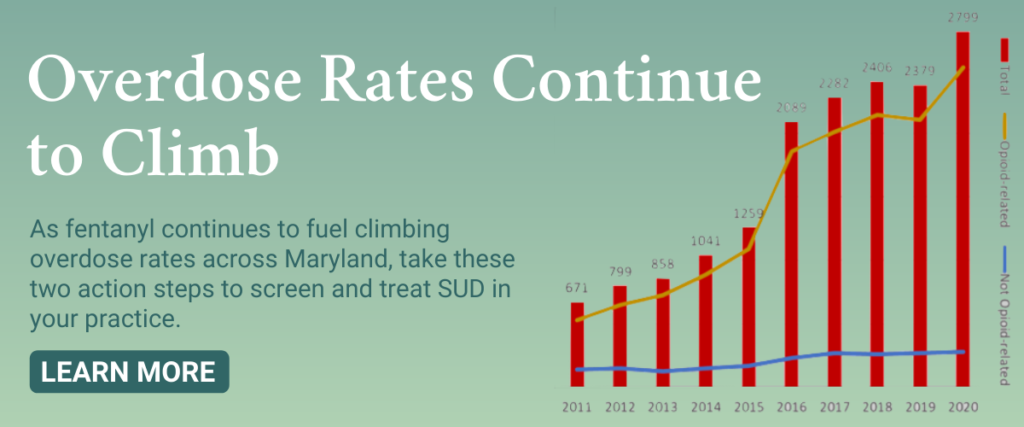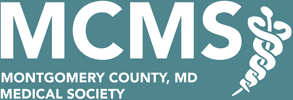
Overdose Rates Continue to Climb: Two Actions for Physicians
The opioid epidemic in Montgomery County and across the region has intensified since the start of the COVID-19 pandemic, with overdoses and deaths spiking. In Maryland, overdose deaths increased 18% from 2019 to 2020. Provisional data from the CDC’s National Vital Statistics System (NVSS) projects another year-over-year increase of 4% in Maryland. In D.C., overdose deaths have spiked 46%, and in Virginia, 41%. Nationally, NVSS projects an increase of 15.9% from 2020 to 2021.
Analysis from the Maryland Department of Health’s 2020 Drug and Alcohol-Related Intoxication Deaths report places Montgomery County in the top five jurisdictions in the state with the highest overdoses. Fentanyl is driving the spike in Maryland; 2,342 overdoses were attributed to fentanyl in 2020. The second-largest overdose category was cocaine with 921 overdoses.
The Pew Research Center broke down the demographic change in overdose death rates from 2015 to 2020. While overdose rates have increased in every major demographic group in recent years, no group has seen a bigger increase than Black men, rising 213%. As a result, Black men have overtaken White men and are now on par with American Indian or Alaska Native men as the demographic groups most likely to die from overdoses. Graphs and tables from NVSS, MDH, and Pew Research are available in the embedded PDF at the end of this article or by clicking here.
The behavioral health system in Maryland is particularly overburdened by the simultaneous surge in demand for mental health support alongside the rising rate of substance use disorder. Clinics are reporting staff shortages across the state.
Two Actions to Combat SUD in Montgomery County
Action 1: Implement SBIRT in Your Practice
SBIRT (Screening, Brief Intervention, and Referral to Treatment) is an evidence-based, comprehensive, and integrated public health approach to the delivery of early intervention and treatment services to patients who have risky alcohol or drug use. Maryland SBIRT aims to address drug overdose deaths, health disparity outcomes among minorities, and healthcare costs in Maryland.
In collaboration with MedChi, The Maryland State Medical Society, and the University of Maryland, MDH offers free virtual, CME accredited SBIRT training. SBIRT billing codes pay $24-65 per encounter. Learn more about billing for SBIRT.
Action 2: Consider Becoming a Buprenorphine Waivered Practitioner
To receive a practitioner waiver to administer, dispense, and prescribe buprenorphine practitioners must notify SAMHSA’s Center for Substance Abuse Treatment (CSAT), Division of Pharmacologic Therapies (DPT) of their intent to practice this form of medication-assisted treatment (MAT). The notification of intent (NOI), or buprenorphine waiver application, must be submitted to SAMHSA before the initial dispensing or prescribing of OUD treatment medication.
Recent Practice Guidelines have allowed for an alternative NOI for those seeking to treat up to 30 patients: The customary NOI requires eligible providers to undertake required training activities prior to their application to prescribe buprenorphine; the alternative type of NOI allows those providers who wish to treat up to 30 patients to forego the training requirement, as well as certification to counseling and other ancillary services (i.e., psychosocial services). Practitioners utilizing this training exemption are limited to treating no more than 30 patients at any one time (time spent practicing under this exemption will not qualify the practitioner for a higher patient limit). This exemption applies only to the prescription of Schedule III, IV, and V drugs or combinations of such drugs, covered under the CSA, such as buprenorphine.
CME accredited training to become waivered is available for free through the American Society of Addiction Medicine online. Learn more about becoming a waivered practitioner.
Citations & Further Reading
- American Medical Association. “Issue Brief: Nation’s drug-related overdose and death epidemic continues to worsen.” February 15, 2022.
- Gramlich, John. “Recent Surge in U.S. Drug Overdose Deaths Has Hit Black Men the Hardest.” Pew Research Center, January 21, 2022.
- Maryland Department of Health. “Drug and Alcohol-Related Intoxication Deaths in Maryland, 2020.” June 2021.
- Rossen LM, Ahmad FB, Spencer MR, Warner M, Sutton P. “Methods to adjust provisional counts of drug overdose deaths for underreporting.” Vital Statistics Rapid Release; no 6. Hyattsville, MD: National Center for Health Statistics. August 2018.
- Taylor, Jennifer. “The Workforce Shortage in Addiction Reaches Crisis Stage.” Treatment Magazine, November 3, 2021.
- The Centers for Disease Control National Vital Statistics System. “Provisional Drug Overdose Death Counts.” March 2022.
